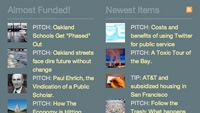News journalism looking for a few good ideas

With both newspapers and television news departments in steep decline, the need for a new model for how to produce and present news content has been pushed to the forefront.
After much experimentation, new forms of journalism are emerging — though much of it is still in the experimental stage. In San Francisco, freelance journalists are using the Internet to solicit story ideas and donations to do the reporting on them. In Chicago, a team of computer programmers connect databases that allow the discovery of local events. And in Bakersfield, CA, there’s an experiment to allow anyone to publish his or her own newspaper.
Some of this new journalism experimentation is being funded by a foundation created by the former publishers of the “Miami Herald” — John S. and James L. Knight —who are now both deceased.
Yet their influence will still be felt through a five-year, $25 million initiative called the Knight News Challenge. One of their projects is Spot.us, created by David Cohn, 26, a freelance journalist in San Francisco. The Knight Foundation give Spot. us $340,000 in seed money last year.
Both journalists and readers propose stories on Cohn’s Web site. Then donations are solicited to cover the reporting costs. If the promised donations reach a preset threshold, usually about $1000, a journalist is dispatched and the story gets done. If not, the story idea is discarded. It’s called participatory investigative journalism.
The written stories or video segments are posted on www.spot.us and can be purchased by a traditional media organization. In such cases, the money raised is refunded to the donors, so they can apply it to another story proposal.
So far, Spot.us has funded more than a dozen stories in the San Francisco Bay Area, from fact-checking political ads to investigating the safety of Bay Area beaches and drinking water after an oil spill.
The professional video industry's #1 source for news, trends and product and tech information. Sign up below.
Another $1.1 million Knight project is www.EveryBlock.com, which links databases so they can be searched and mapped to help users find information specific to their neighborhood or block. The databases include restaurant inspections, building-permit applications, police crime logs and newspaper stories. Showing promise, the site has already been picked up by the “Chicago Tribune” Web site.
Another is Printcasting, which allows citizen journalists to create their own newspaper or magazine and to sell advertising to support it. The idea, which won $837,000 from Knight last year, aggregates feeds from news organizations, bloggers or newsletters that have agreed to provide content. Would-be publishers then pick from the menu to create a niche publication that can be delivered by e-mail, printed at home, or perhaps even published and distributed by a newspaper.
Knight is not the only charity funding new journalistic forms. The John D. and Catherine T. MacArthur Foundation, for instance, fund similar projects, and the Ford Foundation underwrites journalistic research and technology initiatives.
Each of these experiments assume that the new journalism must move beyond old media methods and optimize the carriage of digital data across a variety of distribution platforms.
If the old model is broken, what will work in its place? The answer is anyone’s guess at this point, but the industry as we know it has to continue to explore alternative options or risk extinction.
